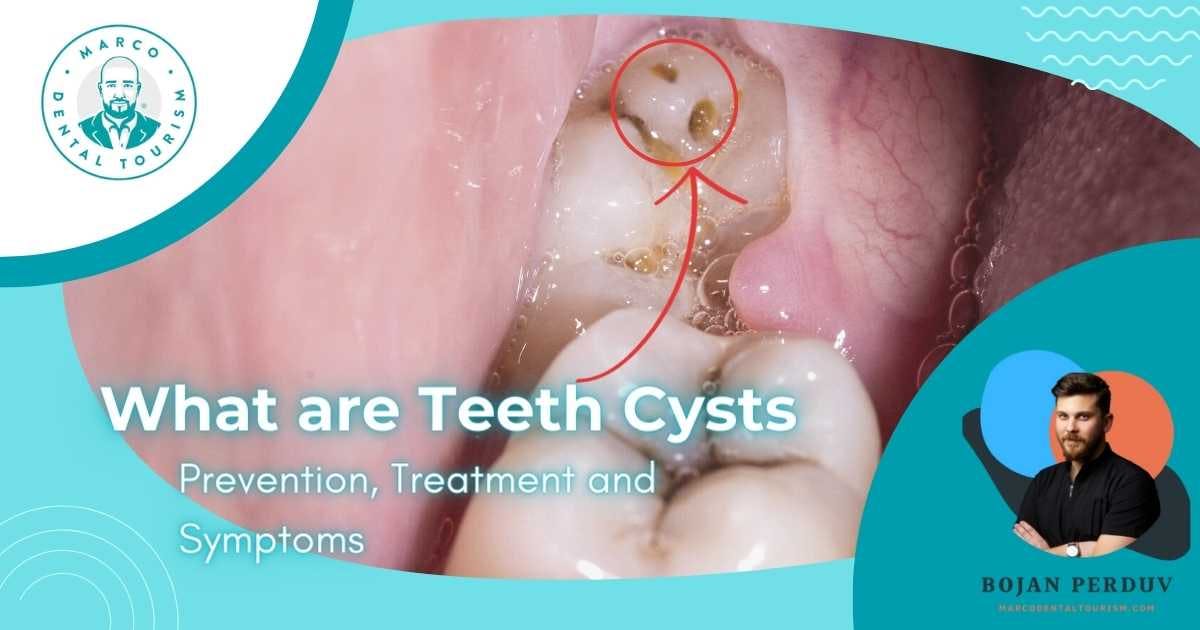What are Cysts on the Teeth: Prevention, Treatment and Symptoms

Has it happened to you that while brushing your teeth, you felt an unusual lump that you are not sure what it is, and that has not gone away for several days? Do not worry! There are chances that it is a dental cyst - but what is a cyst, how is it recognized and how is it treated? In this blog, we deal with cysts on the teeth, find out if there are reasons to worry, as well as what are the causes, symptoms and ways of treating this dental problem.

Dental cysts are a group of fluid-filled sacs that can form around or inside the jawbone. They are usually caused by inflammation, root infection, or trauma or injury to the tooth that can lead to tissue damage, and the most common symptoms include swelling, pain, and difficulty eating.
What are the most common causes of dental cysts?

Dental cysts are caused by the accumulation of fluid in the gums due to bacterial infection or dental trauma. Trauma occurs when a tooth is broken or chipped, allowing bacteria to enter the pulp and cause inflammation, as well as when non-grown teeth appear. impacted teeth, poor hygiene and jawbone defect.
We highlight a list of the most common causes of tooth cysts and explain each of them:
- Infection of the mouth or teeth: Bacterial or viral infections, frequent causes of inflammation of the gums and soft tissues of the mouth, create an environment suitable for the development of cysts and other unpleasant dental diseases.
- Impacted teeth: Due to the lack of space or in cases where the teeth cannot fully erupt, there is an accumulation and formation of bags with fluid that must be adequately healed.
- Sinus infection: Cysts around or in the jawbone itself are most often caused by inflammation in the sinus cavities, i.e. inflammation or a strong sinus infection.
- Trauma: Sports or other injuries to the teeth or gums can cause cysts that form when a small area of tissue becomes inflamed and does not heal in time.
- Poor oral hygiene: Poor dental hygiene, i.e. irregular washing and cleaning of the mouth, teeth and tongue, leads to the accumulation of food residues, the development of bacteria and plaque, and therefore caries, which creates a suitable ground for the formation and development of dental cysts.
What are the common symptoms of dental cysts?

Common symptoms of cysts include swelling, throbbing pain and redness around the affected tooth, difficulty opening the mouth, sensitivity to touch and a bad taste in the mouth. Early diagnosis and treatment are important to avoid complications and infections, which is why it is recommended to see a doctor immediately.
Early symptoms of a dental cyst include the following characteristic symptoms that are important to recognize and treat in time:
- Swelling: One of the early symptoms of a dental cyst is usually manifested by swelling that is visible on the face, neck or around the affected tooth. In addition, a dental cyst can cause swelling of the jaw resulting from the accumulation of fluid in the area.
- Persistent throbbing pain: The swelling is often accompanied by pain, the intensity of which often varies from mild to severe and very unpleasant.
- Discomfort: The patient may feel discomfort in the affected area, such as pain, tenderness, or uncomfortable pressure.
- Bad breath: A cyst can also cause a person to experience bad or unpleasant breath due to the accumulation and spread of bacteria in the mouth.
- Difficulty opening the mouth: Due to swelling, one of the indicators of a cyst on the tooth can be difficulty opening the mouth or chewing food.
What types of dental cysts exist?
Dental cysts are abnormal growths of pus-filled sacs in the teeth and jawbone, the most common types of which are:
- Radicular cyst: This type is the most common form of dental cyst that develops at the end or tip of the root of the affected tooth and is usually caused by a certain infection of the tooth, mostly of the bacterial type.
- Follicular or dentigerous cyst: Forms around the crown of an unerupted tooth, and is a rare occurrence in milk teeth as well.
- Odontogenic keratocyst: These types of cysts form in the jaw due to excessive cell growth. Due to the high aggressiveness, these cysts can cause displacement of the affected teeth or the entire jaw.
- Gingival cyst: These are small cysts that form inside the gums, often due to an untreated bacterial infection. This type of cyst manifests itself in the form of pain and discomfort.
- Traumatic cyst: They occur as a result of an injury to a tooth or jaw bone. As a result of traumatic cysts, toothache, redness, and swelling in the area of the teeth and jaw are most common.
How are dental cysts diagnosed?

Dental cysts are usually detected by an examination, X-ray or CT scan of the teeth. During the examination, the dentist notices signs of infection and inflammation such as swelling, sensitivity and discoloration of the teeth. An X-ray reveals cysts that are hidden under the gums, while a CT scan provides details of the surrounding structures of the tooth.
How to prevent the appearance of a dental cyst?

Prevention of dental cysts begins with maintaining good oral hygiene, which includes brushing your teeth at least twice a day, changing your toothbrush every three months, and regular checkups every 6 months. If you experience toothache or notice any changes in your mouth, contact your dentist immediately.
We suggest a few more ways to effectively prevent the occurrence of dental cysts, as well as other dental diseases:
- Eat more calcium: Eating foods rich in calcium, such as dairy products and leafy greens, can help build strong teeth and bones and prevent dental cysts.
- Keep your mouth clean daily: Brushing and flossing at least twice a day helps remove bacteria and plaque that can build up and cause cavities, which is the main cause of cysts.
- Visit the dentist regularly: Regular dental checkups and cleanings can help spot a potential problem before it becomes more serious.
- Use fluoride: Fluoride helps strengthen tooth enamel and makes it more resistant to cavities and all other forms of dental disease.
What is a cystectomy?
A dental cystectomy is a dental procedure in which a cyst or sac of pus around the tooth is removed. It is usually done when the cyst has caused damage to the root of the tooth or has become infected. The procedure involves removing the cyst and any damaged tissue, usually under general anesthesia.
How is a cyst on a tooth treated?

Treatment of a cyst on a tooth usually depends on its size and location. If the cyst is small and does not cause any pain or swelling, it can be monitored. Larger cysts may need to be surgically drained or removed. Your dentist may also recommend antibiotics or a root canal to relieve the cyst and pain.
Conclusion
Dental cysts are not something to be afraid of. They are a common dental problem that many people face during their lifetime. So now that you've learned all about dental cysts, it's time to be proactive and make sure your teeth are healthy and strong! Schedule regular dental checkups, brush and floss twice a day, and if you notice any unusual bumps or swelling, contact your dentist immediately for a thorough examination and professional treatment.












Share your opinion!
What do you think about this topic?
Comments (0)